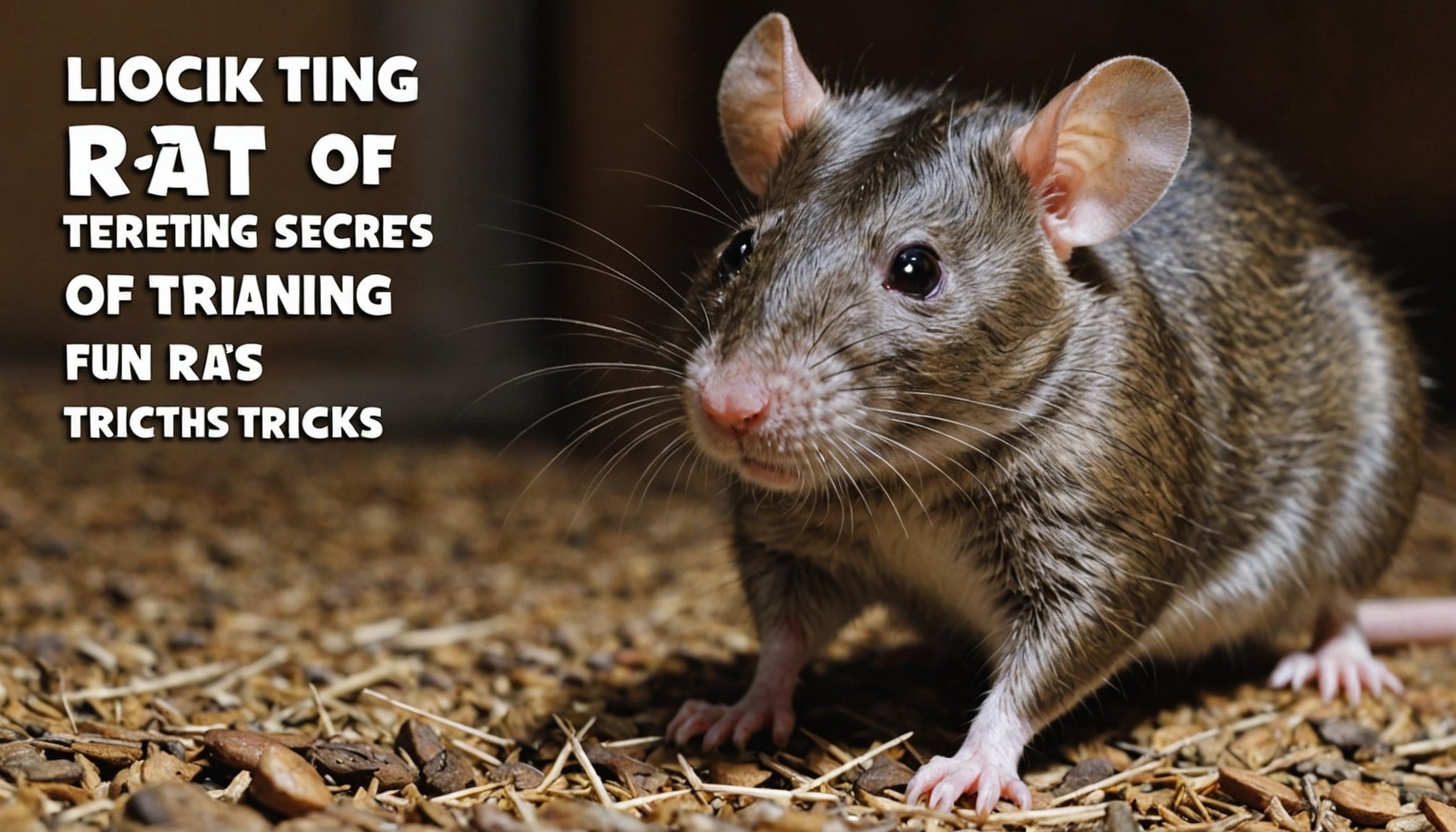Unlocking the Secrets of Rat Training: Expert Methods to Teach Your Pet Rat Fun Tricks
Understanding Your Pet Rat’s Behavior and Learning Mechanisms
Before diving into the world of rat training, it’s crucial to understand the underlying behavior and learning mechanisms of your pet rat. Rats are highly intelligent and curious animals, capable of complex decision-making and learning.
In a recent study, researchers found that rats pursue both food and leisure activities following similar rational principles. When given a choice between earning food rewards and engaging with toy apparatuses, rats adjusted their time allocation based on the opportunity cost of switching between these activities. This behavior is consistent with theoretical models of foraging and reinforcement learning, where rats optimize their time to maximize rewards[1].
Additional reading : Unlocking optimal water conditions: essential parameters for successfully breeding neon tetras in your home aquarium
The Power of Positive Reinforcement
Positive reinforcement is a cornerstone of effective rat training. This method involves adding a desired stimulus, such as food or praise, immediately after the desired behavior is exhibited. This approach increases the frequency of the behavior in the future.
For example, if you want to teach your pet rat to press a lever, you can use positive reinforcement by providing a food reward each time the lever is pressed. Over time, the rat will learn to associate the action of pressing the lever with the reward, increasing the frequency of this behavior[2].
In the same genre : Ultimate guide to caring for african grey parrots in the uk: key responsibilities for enthusiasts
Setting Up Your Training Environment
Creating an enriching and structured environment is essential for successful rat training. Here are some steps to set up your training area:
Choose the Right Toys and Equipment
- Interactive Toys: Use toys that encourage climbing, problem-solving, and exploration. These toys not only provide mental stimulation but also help in developing physical skills. Rotate toys regularly to keep your rat engaged and prevent boredom[5].
- Training Apparatus: You can use simple setups like tunnels, mazes, or even a three-chamber apparatus similar to the one used in the study on rats’ decision-making[1].
Establish a Routine
- Consistency: Establish a regular training schedule. Consistency helps your rat anticipate and look forward to training sessions.
- Positive Reinforcement Tools: Have a variety of rewards ready, such as sunflower seeds, carrots, or even small pieces of cheese.
Training Your Pet Rat: Step-by-Step Guide
Basic Commands
Here are some basic commands you can teach your pet rat using positive reinforcement:
Command: “Come”
- Step 1: Start by calling your rat’s name and offering a treat.
- Step 2: Gradually increase the distance between you and your rat while calling its name.
- Step 3: Reward your rat with a treat each time it comes to you.
Command: “Stay”
- Step 1: Have your rat sit or stand in a specific location.
- Step 2: Take a few steps back and say “stay.”
- Step 3: If your rat stays, reward it with a treat. If it moves, go back to the starting position and try again.
Command: “Fetch”
- Step 1: Place a toy or small object near your rat.
- Step 2: Encourage your rat to pick up the object and bring it back to you.
- Step 3: Reward your rat with a treat each time it successfully brings the object back.
Advanced Tricks
Once your rat is comfortable with basic commands, you can move on to more advanced tricks:
Trick: “Spin”
- Step 1: Hold a treat above your rat’s head and move it in a circle.
- Step 2: As your rat follows the treat with its nose, it will naturally spin around.
- Step 3: Reward your rat with the treat once it completes a full spin.
Trick: “Tunnel Run”
- Step 1: Set up a tunnel or maze.
- Step 2: Place a treat at the end of the tunnel to encourage your rat to run through it.
- Step 3: Reward your rat with the treat once it emerges from the tunnel.
Tips for Effective Training
Avoid Damage and Stress
- Be Patient: Training should be a positive experience for your rat. Avoid pushing your rat too hard, as this can lead to stress and damage to your pet’s health.
- Use Positive Reinforcement: Always use positive reinforcement techniques to encourage desired behaviors. Avoid punishment or negative reinforcement, as these can lead to fear and mistrust.
Monitor Health and Stats
- Health Checks: Regularly check your rat’s health to ensure it is fit for training. Look for signs of illness or stress.
- Training Stats: Keep track of your rat’s progress. Note which tricks it learns quickly and which ones it struggles with. Adjust your training schedule accordingly.
Interactive Toys and Their Benefits
Using interactive toys is a great way to keep your pet rat engaged and stimulated. Here are some benefits and tips for using these toys:
Benefits of Interactive Toys
- Mental Stimulation: Interactive toys encourage problem-solving and exploration, keeping your rat’s mind active.
- Physical Activity: Toys that encourage climbing, running, and other physical activities help maintain your rat’s physical health.
- Reducing Stress: Engaging with toys can alleviate stress and boredom, leading to a happier and healthier pet.
Examples of Interactive Toys
- Climbing Structures: Rats love to climb. Use climbing structures or ladders to provide physical activity.
- Puzzle Toys: Puzzle toys that dispense treats when solved are excellent for mental stimulation.
- Tunnels and Mazes: These provide a fun and challenging way for your rat to navigate and explore.
Table: Comparing Different Training Methods
| Training Method | Description | Benefits | Drawbacks |
|---|---|---|---|
| Positive Reinforcement | Adding a desired stimulus after the desired behavior. | Increases frequency of desired behavior, builds trust and confidence. | Requires consistent reinforcement, can be time-consuming. |
| Negative Reinforcement | Removing an aversive stimulus after the desired behavior. | Increases frequency of desired behavior, but can lead to anxiety. | Can be stressful, may not be as effective in the long term. |
| Shaping | Gradually changing behavior through reinforcement of approximations. | Highly effective for complex behaviors, builds strong learning foundation. | Requires patience and consistent reinforcement. |
| Noncontingent Reinforcement | Providing reinforcement regardless of behavior. | Can reduce undesired behaviors by reinforcing alternative responses. | May not strengthen desired behaviors, can be confusing for the animal. |
Real-Life Examples and Anecdotes
The Robot Rat Experiment
In a fascinating experiment, researchers created a robot rat that could interact socially with real lab rats. The robot was trained using AI and deep learning to mimic the behaviors of real rats, including playful and aggressive interactions. This study highlights the complexity of rat behavior and the potential for using technology to understand and interact with rats better[4].
Customer Reviews on Interactive Toys
Many pet owners have reported positive experiences with interactive toys. For example, one owner noted, “Using puzzle toys has significantly reduced my rat’s stress levels. It keeps them engaged and active, and they seem to enjoy the challenge of getting the treats out.”
Training your pet rat is a rewarding and enjoyable experience for both you and your pet. By understanding the principles of positive reinforcement, setting up an enriching environment, and using the right training methods, you can teach your rat a variety of fun tricks and strengthen your bond.
Remember to be patient, avoid stress and damage, and always use positive reinforcement techniques. With time and practice, your pet rat will become a skilled and happy companion.
Final Tips
- Make Sure to Rotate Toys: Keep your rat engaged by rotating toys regularly.
- Order Your Training Sessions: Establish a consistent training schedule to maximize learning.
- Pet Your Rat Often: Physical interaction strengthens the pet bond and helps in training.
- Level Your Expectations: Be realistic about what your rat can learn and at what pace.
By following these tips and using the methods outlined above, you can unlock the full potential of your pet rat and enjoy a fulfilling and fun training experience.











